Natural News is crying foul over Google’s blacklisting of their domain. Being a veteran SEO (18+ years as an SEO) and a person who strongly believes in free speech and access to information, I was intrigued. Has Google really crossed the line into making judgements on real or fake news? Is Google now penalizing alternative news or sites that write negatively about Google? Or is Natural News simply misinformed about a penalty unrelated to their stances? Let’s take a look.
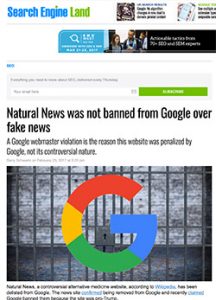 I first noticed the blacklisting through Facebook friends posts and on Twitter. I noticed Barry wrote a piece over on Search Engine Land yesterday. Search Engine Land is a good place to start with any search-related controversy as they have writers like Barry who have been in the industry as long as I, as opposed to most other publications with writers that have no SEO expertise and no access to Google.
I first noticed the blacklisting through Facebook friends posts and on Twitter. I noticed Barry wrote a piece over on Search Engine Land yesterday. Search Engine Land is a good place to start with any search-related controversy as they have writers like Barry who have been in the industry as long as I, as opposed to most other publications with writers that have no SEO expertise and no access to Google.
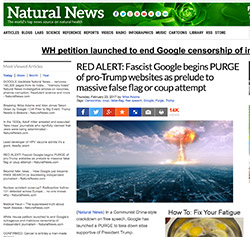 The article points to this article about the Google ban over on the Natural News site. As Natural News sees it, this is a direct attack on free speech and an attack against them and their founder. They also say they had no messages from Google about the ban and they show a screenshot of their Google Search Console account showing they don’t have any malware warnings.
The article points to this article about the Google ban over on the Natural News site. As Natural News sees it, this is a direct attack on free speech and an attack against them and their founder. They also say they had no messages from Google about the ban and they show a screenshot of their Google Search Console account showing they don’t have any malware warnings.
Search Engine Land was also able to get the following statement from Google:
‘We don’t comment on individual sites, but if we find that a site violates one or more of our Webmaster Guidelines we may take manual action against it. For webmasters who have questions about their own sites, our Webmaster team provides support through platforms such as the Webmaster Forums. Once a site has remedied the problem, the webmaster can submit the site for reconsideration.’
As usual, Google doesn’t provide much information about the ban which leads us to investigate it ourselves or rely on experts to chime in (or amateurs to draw quick conclusions). To date, no one has stepped up, which prompted me to take a look.
Before I get started, I do want to state that I believe Natural News should be in Google’s index. First, because I think they should have the freedom to post content that can be found, but also because I think it is important for both sides of an argument to have a voice so we can draw our own conclusions. With the consolidation of news outlets, their political bias has grown far too large, in my opinion. Much of the manipulation by major outlets was well documented in the primary and the DNC hacks/leaks. Independent news sites are important to maintaining one of the greatest gifts provided by the Internet: transparency.
So let’s set aside any arguments over fake news or politics and just look to see if Natural News is victim to actual Google guideline violations and doing things that have gotten many other sites banned in the past.
It is easy to confirm Natural News is, indeed, removed from Google’s index. They don’t show up for a search for their own name, nor a specific site: search:
We do know that Google has penalized “fake news” sites on the publisher ad display side, but we have no evidence Google has blacklisted a site for this reason (nor do I expect we would). Google has far more information to go off of than I do, but digging into the Natural News site I did see a lack of SEO expertise as many basic mistakes were being made.
But lack of expertise itself isn’t ban-worthy. Did Natural News do anything intentionally, or unintentionally to get itself banned? One of the first places to look is their backlinks. Were they buying links? That’s what got JC Penny banned. Quickly glancing at a couple backlink analysis tools, I don’t see any obvious link buying.
How about cloaking? Showing users one thing and Google another is what got BMW banned. Based off a couple quick checks, I don’t see them cloaking.
How about keyword stuffing or non-visible text? I didn’t see any of the super old SEO spam like white text on white background, nor any crazy CSS negative absolute position tricks.
After further browsing of the site, I did come across a few issues that could certainly warrant a ban from Google:
Hidden Links
Often sites that are hacked have hidden links attempting to provide link equity (aka votes by linking) to other sites, not visible by users. I did find a hidden form link, but it wasn’t from a hack. It was to the benefit of an alternative search engine that is owned by the same editor-in-chief as Natural News. Here’s the offending code:

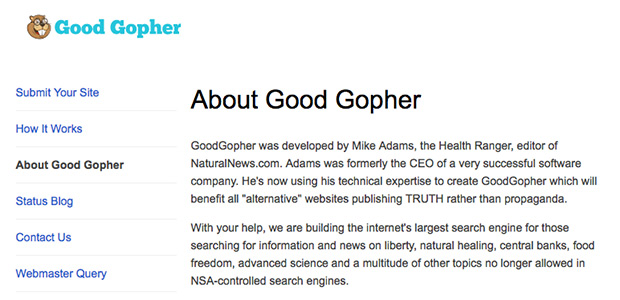
Allowing Advertisers to Buy Followed Links
This one may be completely unintentional, but Natural News has created an ad platform that allows advertisers to buy links that pass link equity (major Google violation). The way it happens is a bit tricky. Take this organic raw cashew ad, for example:

If you view the source code, you see this:

 That’s a followed link to a page called http://www.naturalenews.com/SBA-407.html, but when you try to visit that page, you are immediately redirected to the advertiser site. The redirect is a poor-man’s redirect, a meta refresh which is treated by Google as a pseudo 301 redirect which passes link equity, or a vote for the advertiser.
That’s a followed link to a page called http://www.naturalenews.com/SBA-407.html, but when you try to visit that page, you are immediately redirected to the advertiser site. The redirect is a poor-man’s redirect, a meta refresh which is treated by Google as a pseudo 301 redirect which passes link equity, or a vote for the advertiser.
There’s many other examples as well. Here’s one more:


It’s possible Natural News is innocently using this system to track ad clicks, but the link should have been no-followed so it didn’t count as a vote for the advertiser site.
Massive UGC Spam
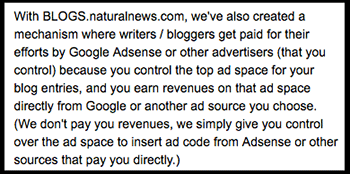 Natural News has set up a blogging platform for writers which, nobly, allows the writers to make money off the site for their efforts.
Natural News has set up a blogging platform for writers which, nobly, allows the writers to make money off the site for their efforts.
The problem is they aren’t policing it well and they’ve allowed writers to embed their own ads and code. Having worked for a number of the world’s most popular user generated content sites & platforms, I know it takes a lot of work to keep spammers off your platform and to keep the content focused on the types of content that belong on the site.
It looks like some of the writers have had their Adsense accounts banned while embedding it into their site posts:
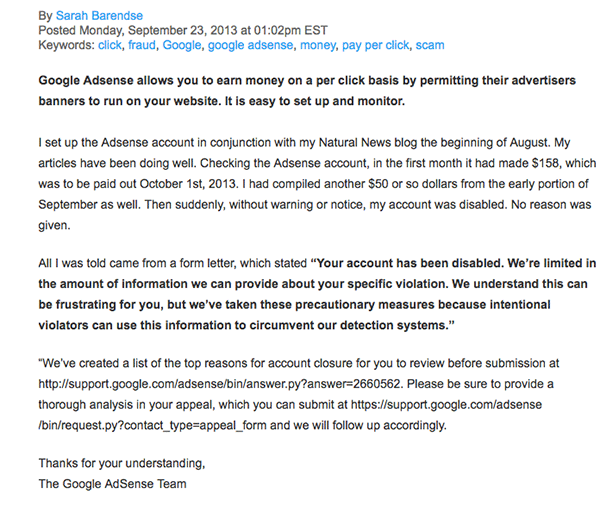
But the bigger issue is that the blogs are a free-for-all with many users dropping in affiliate links, unnatural links, and completely off topic posts. For example, look at author julia2’s work:

Do those articles look like that make sense on a site about natural health? Natural health Power Point presentations, IP tracking, credit cards and personal loans? She also drops some nice spam links in to what I assume are paying clients:

I do credit Natural News for making sure most UGC links are no-followed.

Julia likely doesn’t realize her links are no-followed or she’d stop spamming the site, though some spammers are ok with using the authority of a site like Natural News to rank high – using it as their spam site.
This isn’t just a Julia thing. The site has thousands of writers working in their own spammy interest:








We’ve even got SEO advice on Natural News:

And a lot of activity out of an Australian SEO agency who says on their site that they guarantee results, but won’t let you know how they are getting links:

Summary of the Natural News Google Ban
Having been in the SEO industry for over 18 years, I’ve certainly criticized Google from time-to-time, but until Natural News addresses many Google Webmasters violations I display above, there appears to be no evidence Google is playing favoritism or going after sites politically on the organic search side of things.
The blacklisting is, in fact, due to the site’s own activities that violate Google’s guidelines. Another site doing the same things I highlighted would also be banned. Since it appears it was due to negligence or lack of SEO expertise on the part of Natural News side, I can understand why they were confused and upset, drawing their own incorrect conclusions. Natural News simply needs to clean their site up and request reconsideration. Hopefully my article helps them get back into the index.
There are many things that I didn’t look at that I would normally look at in an SEO audit, including crawling the site with various robot simulators, investigating some their sketchy robots.txt file exclusions, and taking a look at their cross linking between their own domains (I do expect there is a lot of this happening on this site). There’s also word that they do some spammy mobile redirects that I didn’t look into. Even when they were in the index, I expect they were hampered from technical SEO issues.
Don’t Let Your Marketing Efforts Get Blacklisted: Tips for Preventing Email Spam Filters from Flagging Your Messages
Are your marketing emails consistently getting marked as spam, despite your best efforts? This can be frustrating and damaging to your brand’s reputation. Being blacklisted by email providers can prevent your messages from reaching your audience, making it difficult to grow your business.
Luckily, there are steps from marketing heaven you can take to prevent this from happening. Here are some tips for keeping your marketing work out of the spam folder:
Avoid spam trigger words: Certain words and phrases are commonly associated with spam emails, such as “free,” “act now,” and “click here.” Be mindful of your language choices and try to avoid these trigger words.
Use a reputable email service provider: Choose a provider with a good reputation and avoid free email services. These providers often have poor deliverability rates and are more likely to be flagged as spam.
Get permission: Only send emails to people who have given you explicit permission to do so. This can be done through opt-in forms on your website or by obtaining consent in person.
Segment your email list: Segmenting your list allows you to send targeted messages to specific groups of people, increasing the likelihood of engagement and reducing the chance of getting flagged as spam.
Make it easy to unsubscribe: Providing a clear and easy way for subscribers to opt-out of receiving your emails can help prevent them from marking your messages as spam.
By following these tips, you can help ensure that your marketing work stays out of the spam folder and reaches your intended audience. Don’t let your hard work go to waste – take action to protect your reputation and maintain a strong relationship with your customers.
If you have questions or want further clarification, please leave me a comment & I’ll do my best to answer your questions.



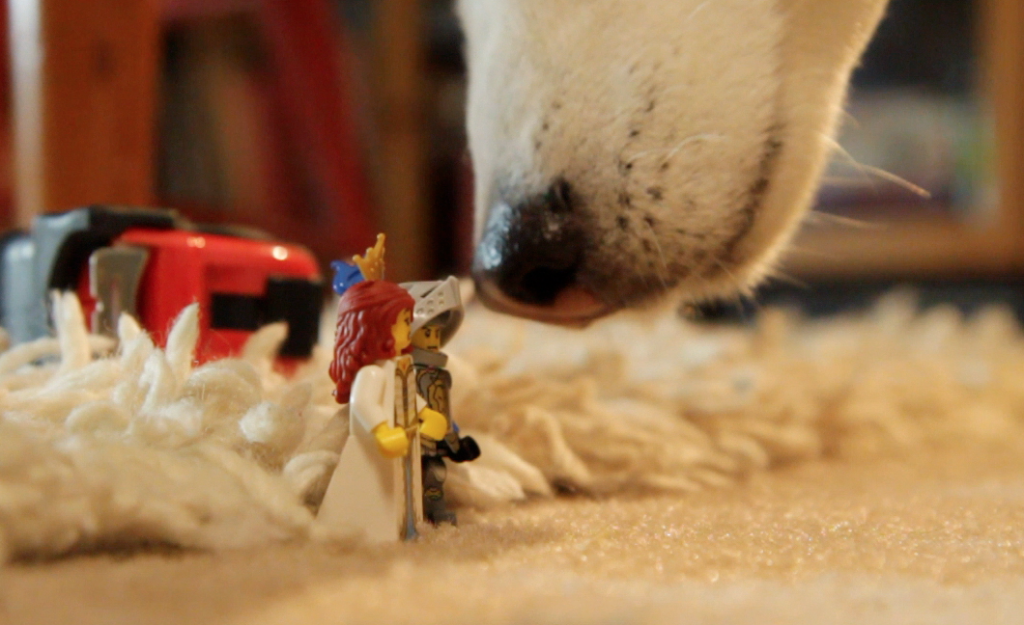
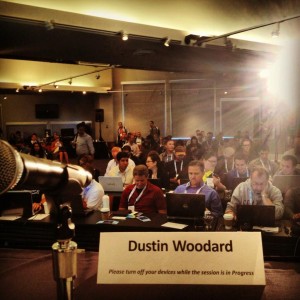 Yesterday I spoke at SMX Advanced for the first time (though I have attended all of them). My talk & our entire session’s presentations on link building/acquisition seemed to go really well. I was a little nervous as the room was full of 800+ of the world’s most advanced SEOs.
Yesterday I spoke at SMX Advanced for the first time (though I have attended all of them). My talk & our entire session’s presentations on link building/acquisition seemed to go really well. I was a little nervous as the room was full of 800+ of the world’s most advanced SEOs.